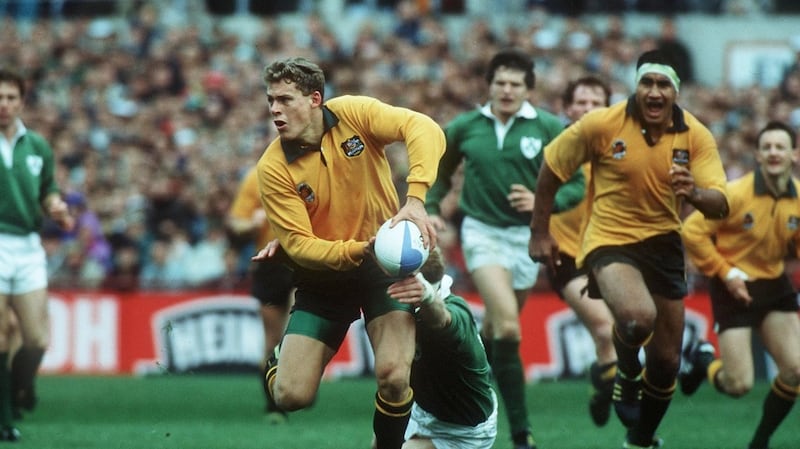When I arrived to my first club training as a player with Swansea Athletic, in the mid 1980s, I was dumbfounded that the centres were named left and right, not inside and outside. The system was, on the left side of the field, the left centre was at inside centre and on the right side of the field, the same left centre was at outside centre.
There was no such animals as inside or outside centre.
Years later, when I related this story to the late Ray Gravell, who famously wore the Welsh number 13 jersey, he smiled his most beautifully disarming smile and said,"Mattie, I didn't care about the number on their back. I just belted them." When Ray played, there was a sign held aloft at the old Cardiff Arms Park that read, "Ray Gravell eats soft centres." And he did.
A centre pairing is like selecting the perfect wine to have with a local cheese. They will be very different in substance, but the combination can be superb.
It is the subtle attacking and defensive qualities required for an international standard outside centre that make the number 13 a very unique position to that of a 12.
The faster you run at a defensive line, the slower it will come forward.
I have been fortunate to have coached two of modern rugby's greatest outside centres. The wonderful Jason Little, a two time RWC winner and the best of them all, Brian O'Driscoll. Like most aspects of rugby theory, much of outside centre play is counter intuitive.
Areas to attack
The faster you run at a defensive line, the slower it will come forward. The closer you start your attacking alignment to the defenders, the more pressure you place upon them. If you have a flat close alignment and run at the defender who is marking you, the easier it is to take him out of the defending play and so create space in other areas to attack.
While Jason and Brian were very different athletes – Jason was a tall, athletic sprinter and Brian was gifted with blistering acceleration – they also had key attributes in common.
In attack, before they received the ball they both started where they were not going to be. They could run slight “unders” lines, back towards the ball, before it was passed to them, bringing their defender in. They would then change direction, away from the ball, receive the ball and manipulate their defender to attack his outside shoulder. They are the only two I have witnessed successfully perform this incredibly difficult running line.

In defence they shared one extremely powerful quality. They trusted their inside centre’s communication. On defending right hand scrums, the backs only have four in the defensive line, with the fullback and blindside wing covering the back field and the blindside. The attacking backs have six players. It is the defending outside centre that has the split second decision to make, when to hold or slide onto another defender.
Jason Little and Tim Horan were the best centre paring I have seen wearing a gold jersey. Gordon D'Arcy and Brian were the best in a green jersey. Jason and Brian completely trusted their inside centre's call. A good inside centre simply calls, "Go, I have the ball." Meaning he will take the man with the ball, "you're good to go" and cover the next man. Great outside centres trust the "go". Hesitate, or turn your hips in field, and all is lost.
The sign of a true great is that they make the difficult look easy. Both Jason and Brian drifted in defence with effortless grace and made sensational tackles in hundreds of matches.
The last part of the outside centre equation is their work at the tackle in the wide channels. By its very definition, wide attack means the ball is along way from the back row and support. The first to arrive is usually the outside centre. Brian was peerless in his ability to disrupt opposition ball in the wide channels either as the tackler or as the first arriving player.
Burden
Today Chris Farrell has the toughest assignment of any player at the Aviva. This is a heavy burden to place on the shoulders of a young man in only his third Test, but the championship will ride on Farrell's performance.
For the talented, giant of a man, the question remains, under the extreme pressure of a Six Nations crunch match, can Bundee Aki and he combine, like a silky Shiraz and a chunk of gloriously stinky Roquefort, to be greater than the sum of their parts? (They can argue which of them is Silky and who is Stinky!)
The Welsh coaches will have identified that the last five metres of Ireland's defensive system has been its weakness
Today when Ireland defend a right-hand side scrum, the fearfully inexperienced defensive axis will be, Aki (four caps,) Farrell (two caps) and Stockdale (six caps.) No wonder coaches go grey.
The problem is magnified because Wales will be attacking Ireland in the channel outside 13. The Welsh coaches will have identified that the last five metres of Ireland’s defensive system has been its weakness. Argentina, France and Italy have all found joy on the extremity of the Irish defence.
Seán O’Brien’s comments, regarding the Welsh contingent of the Lions coaching staff, will be ringing in the ears of the Welsh team.
If Ireland hesitate, as Bill McLaren famously stated, “They will be singing in the valleys of Wales tonight.”
I have no idea why the bookies have Ireland as favourites.This will be a proper Test match.












